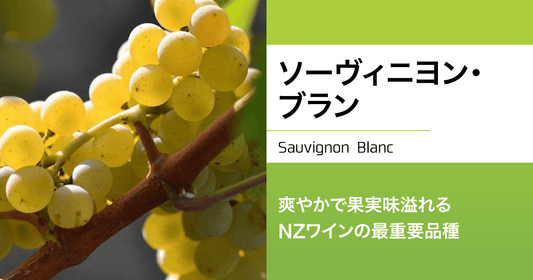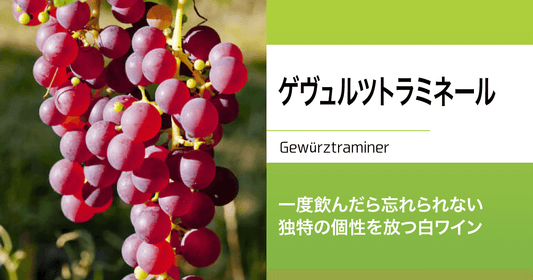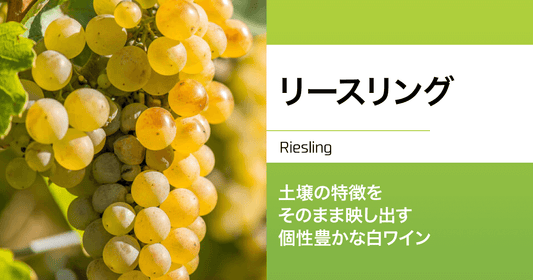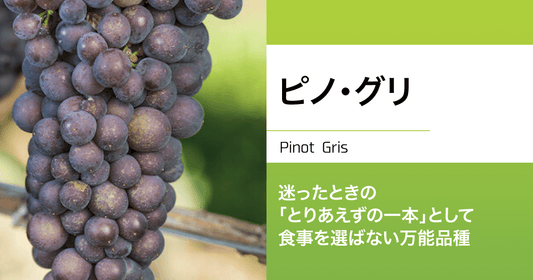
Riesling , a white wine grape variety, is the most important in Germany.
Its characteristics include a rich aroma, clear and delicious taste, and a wide range of unique flavors.
It is difficult to grow, requiring a cool climate and poor soil , and it reflects the unique characteristics of the soil, showing vastly different faces depending on where it is grown.
In this article, we will explain Riesling in an easy-to-understand manner.
Characteristic aroma and crisp acidity
The defining feature of Riesling is its crisp acidity.
In addition, there is a wide variety of noble rot wines , from dry to sweet to very sweet, so they can be enjoyed in a variety of situations, from casual to formal dinners.
When young, its sharp acidity stands out, but it is this acidity that allows it to be aged for a long time, not just 10 or 20 years, but some wines that have been aged for nearly 100 years.
The aroma is of fruits such as lemon, lime, and apple, but as it ages, the sweet aroma of tropical fruits becomes more prominent. It also has a characteristic petroleum aroma called "petrol aroma," which is why it has so many fans.
Riesling is characterised by its petrol-like aroma.
That's right. Please give it a try! It will be fun once you realize, "Ah! This is the petrol scent."
Outside of Europe, this flavor can often be detected even in young Rieslings.
In Germany, sugar content is used for grading. For this reason, many wines with high sugar content and low alcohol content were produced in the past, but recently, in line with the global trend, the production of dry wines has increased.
Dry wine means that the abundant sugar in the grapes has been converted into alcohol, which naturally results in a higher alcohol content, making it a more robust wine.
And it is the cold, poor soil that creates these characteristics.
High-quality Riesling grows only in the cold, poor, and harsh soil
Riesling thrives in cool, poor soils.

It is resistant to cold and grows slowly, so when grown in harsh environments with little water, it produces very firm fruit with high sugar content and strong acidity.
This balance of sugar and acidity is what makes Riesling so special.
The high sugar content means that the wine can be made in a wide range of flavors, from sweet to dry, depending on the producer, but on the other hand, the alcohol content can become too high if the fermentation process continues.
The control of acidity, sugar and alcohol content can be said to be where the producer's principles, beliefs and skill are put to the test.
This Riesling's unique characteristics are less pronounced in warmer climates and are considerably weaker than in cooler regions.
Native to the Rhine basin in Germany
Riesling originates from the Rheingau region of Germany.

Currently, it is not an official name, but is used only to refer to the wine-producing region. The soil carried by the Rhine and the cool climate make this an ideal place for growing Riesling.
Cultivation then spread to the Alsace region of France, which is close by and has a similar environment in the Rhine basin, and to Austria, which is along the Danube River and has a similar climate.
Today, it is cultivated and produced all over the world, including outside of Europe, and the soil of each producing region gives it different characteristics that make it appealing.
Next, let's look at New Zealand Riesling.
New Zealand Riesling
NZ's Riesling harvest is the sixth largest in the country.
First place goes to Sauvignon Blanc , with a harvest of about 300,000 tons, while Riesling only accounted for 4,700 tons, just 1/63 of that.
However, the high quality and unique Riesling produced in New Zealand is highly regarded and is also known as a "premium wine."
It is available in a wide range of styles, from dry to very sweet, and there are even shelves in wine stores across Japan dedicated to Riesling.
On the label, the terms dry, semi-dry, off-dry, and sweet (semi-sweet) are commonly used to describe the range of tastes from dry to sweet. (By the way, semi-dry and off-dry are almost the same thing.)
Although production volume is small, it is widely cultivated throughout the country.
The representative production areas are:
- Marlborough Region
- Wairarapa
- Canterbury/Waipara Region
- Central Otago
And so on.
- Cool region (South Island) = crisp acidity
- Warmer regions (North Island) = stronger aroma
It has the following characteristics:
The world's leading Riesling producing region
Next, we will introduce Rieslings from around the world, including Germany.
Germany
As mentioned earlier, Germany is the birthplace of Riesling.
Even today, roughly half of the world's production is in Germany.
The two major wine-producing regions are the Rheingau region along the Rhine River and the Moselle region along the Moselle River.
Formerly known for its high quality sweet wines, the region is now increasingly producing dry wines of the same quality.
Alsace, France
Alsace is in the northeast of France.

It borders Germany and Switzerland, and is located upstream of the Rhine River, about two and a half hours by car from the Rheingau region, Germany's major wine-producing region.
In Alsace, the "Grand Cru of Alsace" was established in 1975 as a "premier vineyard (a vineyard recognized as having particularly high quality)". Only the following four types of white wine are recognized as eligible for this classification.
- Riesling
- Pinot Gris
- Muscat
- Gewurztraminer
Among these, Riesling is the main variety in Alsace, and is the region that produces high-quality wines.
Austria
Austria also shares borders with Germany and Switzerland and is home to the Alps.
Away from the Atlantic Ocean, it has a dry continental climate with cool summers and very cold winters.
This climate is ideal for Riesling wine production, and these characteristics are shared by Germany, France and Alsace.
The two most famous Riesling producing regions in Austria are Wachau and Kamptal.
The well-drained soils brought by the Danube River in the Wachau and the Kamp River in the Kamptal can be said to have an environment similar to that of the Rhine River in Germany and Alsace.
Rivers often play an important role in wine production.
Australia
The main Riesling producing regions in Australia are Clare Valley and Eden Valley.
The southwest coast of Australia has a Mediterranean climate, similar to most European countries bordering the Mediterranean Sea.
The region is located at a high latitude (southern), and has cool summers and cold winters, a characteristic that is further strengthened by its altitude. Although there is a certain amount of precipitation in winter, the summers are sunny and dry, which has led to the thriving wine production area.
The soil is also similar to that of the Mosel and Rhine in Germany, making it extremely suitable for Riesling production.
America
New York is the most famous Riesling producing region in the United States.
We tend to think of Manhattan as a big city, but that's New York City. New York City is at the southern tip of New York State, but the state is much larger, stretching out to the north and west.
In the western inland area, there is a region called the Finger Lakes. It is close to Lake Ontario and Lake Erie, and also has the finger-shaped lakes that gave it its name. These allow cool breezes to blow in from the lakes in summer and prevent the temperature from dropping too low and frost in winter.
This is New York State's top wine producing region, and in recent years Riesling has been gaining attention and a worldwide reputation.
It goes well with a wide range of dishes, including seafood, vegetables, and cheese.
Well, that concludes our basic knowledge about Riesling.
Next, I'll show you what kind of food it goes well with.
Riesling comes in a wide range of flavors, from dry to very sweet, so let's take a look at each one.
If you want something spicy, try pork, chicken, smoked meat, seafood, or anything else.
Dry Riesling is a fairly versatile wine.
From lightly seasoned pork and chicken dishes to smoked meats such as sausages and bacon.

It goes well with prosciutto, and also with white fish, salmon, and other seafood, which are unique to white wine.
Sweet Riesling goes well with Japanese food!
Riesling, which is classified as semi-dry to semi-sweet, with a hint of sweetness, goes well with Japanese food.
If you wash down the salt and saltiness of the soup stock with a slightly sweet Riesling, you will find it to be similar to sake, but lighter in flavor.
It goes well with white fish and tempura.

Very sweet, pair with sweet and sour desserts
Very sweet wines are called "dessert wines" and are served with dessert at the end of a meal at high-end French restaurants.
There are wines that are that sweet!
Very sweet wines are very rich, so they are best enjoyed with something just as sweet.
In daily life, it can be enjoyed in ice cream, chocolate, cheesecake, fruit cake, or even blue cheese.

summary
Riesling is characterized by its crisp, clean acidity. It is also a grape variety with great potential, as it can be transformed into a wide variety of flavors, from dry to medium dry to sweet to very sweet.
Although it does not appear in all wines, the petrol aroma that can be felt as the wine ages is one characteristic you will want to experience.
It's also recommended as a white wine for beginners to try. Please give it a try.






